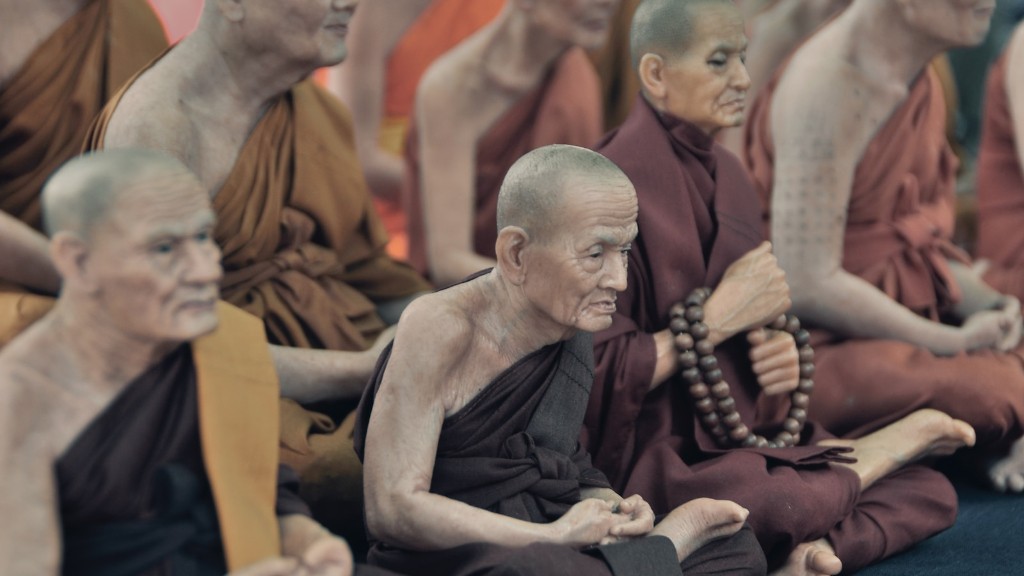Buddhism teaches that suffering is caused by our attachments to things that are impermanent. This can be things like our possessions, our relationships, or even our own thoughts and feelings. The Buddha taught that we can end our suffering by letting go of these attachments.
According to Buddhism, the cause of suffering is desire. Suffering arises when we want things to be different from the way they are. This can be things like wanting to be happy all the time, or wanting to never experience pain or suffering. The way to end suffering is to let go of these desires. This doesn’t mean that we never experience happiness, but rather that we’re not attached to happiness or suffering.
How do Buddhist respond to suffering?
As Buddhists, we believe that we can help to relieve the suffering of others through our actions. One way we can do this is by practicing compassion, or karuna. This involves understanding the suffering of others and wanting to help them remove it. Another way we can help others is through metta, or loving-kindness. This is the desire to wish others well and to help them find happiness. By practicing these things, we can help to make the world a better place for everyone.
The first level of suffering, “the suffering of suffering,” refers to the physical and mental pain that we experience in our lives. This includes the pain of birth, sickness, old age, and death. It also includes the pain that we feel when we are separated from our loved ones, or when we are faced with difficult challenges.
The second level of suffering, “the suffering of change,” refers to the fact that everything in life is constantly changing. We can never hold on to anything for very long. Everything is in a state of flux, and this can be a source of great suffering.
The third level of suffering, “the suffering of conditioning,” refers to the fact that we are all conditioned by our past experiences. We are products of our upbringing, our culture, and our environment. We are not free to be who we truly are. We are always reacting to the world around us, and this can be a source of great suffering.
What are Buddhist teachings about suffering
The Buddha’s teaching on suffering is based on the fact that life is full of change and impermanence. This means that everything we experience is temporary and subject to change. This can be a difficult pill to swallow, but it’s an important part of the Buddha’s teaching. The Buddha helps us to see that suffering comes from our attachment to things that are constantly changing. When we let go of our attachment to these things, we can find true happiness.
From a Buddhist perspective, pain can be seen as a sacrifice that can benefit all beings. By enduring pain and suffering, Buddhists believe that one can reach a higher state of consciousness. If your patient wishes to perform religious rituals such as quiet reflection, chanting, meditation, and prayer, it is important to allow him or her periods of time alone to do so.
Does Buddha believe in suffering?
Buddhism is one of the world’s oldest and largest religions. It began in India over 2,500 years ago and teaches that the human life is one of suffering. Buddhists believe that meditation, spiritual and physical labor, and good behavior are the ways to achieve enlightenment, or nirvana.
The Buddha’s first noble truth is often misunderstood to mean that life is suffering. However, the Pali word dukkha actually has a more subtle range of meanings. Dukkha can refer to the inherent unsatisfactoriness of all things, the transient nature of all things, or the fact that everything is subject to change. Therefore, life is not necessarily suffering, but it is always subject to change and impermanence.
What is the cure of suffering?
The Buddha taught that the way to extinguish desire, which causes suffering, is to liberate oneself from attachment. This is the third Noble Truth – the possibility of liberation. The Buddha was a living example that this is possible in a human lifetime.
These are known as the Five Heavy Sins, and they are considered to be the most serious offenses that a Buddhist can commit.
What did Buddha said about death and suffering
The lesson on death and suffering that Buddha taught Kisa Gotami through an activity is that death and suffering are common to all. He said that there was no way by which one could avoid death or suffering. He compared it to an earthen vessel made by a potter, which would sooner or later die.
It is often said that the first step to recovery is admitting that you have a problem. In order to let go, you must first come to terms with the fact that there is something that you need to let go of. This can be a difficult and painful process, but it is a necessary one. After you have acknowledged the issue, you can begin to take steps to letting go.
One of the best things you can do is to create a positive mantra to counter the painful thoughts. This will help to reframe your thoughts and give you something positive to focus on. Additionally, physical distance can be helpful. If you are constantly reminded of the person or situation that you are trying to forget, it will be more difficult to do so. Give yourself some space to heal.
Do your own work. This means that you should not try to fix or change the other person. focus on yourself and your own healing. Practice mindfulness and be gentle with yourself. Accept that the other person may not apologize. This is not about them, it is about you.
Finally, engage in self-care. This is an important step to take after any difficult experience. Make sure to take care of yourself emotionally and physically. Letting go is a
Can Buddhists take medication?
As Buddhists, we are always looking for ways to improve our mental and physical wellbeing. However, we are also very aware of the potential dangers of taking any substance that could alter our state of mind or clarity of thought. For this reason, we may be more cautious when it comes to taking medication that could have such effects.
Depression and anxiety can be incredibly debilitating. Aside from the powerful philosophy within Buddhism, many people who suffer with depression and anxiety report that one practise within Buddhism, meditation, or ‘mindfulness meditation’, helps them to manage their thoughts and feelings.
Mindfulness meditation is a form of mindfulness practise that can be done anywhere, at any time. All you need to do is focus your attention on your breath and on the present moment. This can help to ground you and to stop your mind from racing ahead and dwelling on negative thoughts.
There is plenty of scientific evidence to support the use of mindfulness meditation for treating depression and anxiety. If you suffer from either of these conditions, it could be worth giving it a try.
What are the 4 types of suffering
Pain and suffering come in many different forms, and it can be difficult to pinpoint the source of someone’s pain or suffering. Qualifiers, such as physical, mental, emotional, and psychological, can help to identify the type of pain or suffering someone is experiencing. By understanding the source of someone’s pain or suffering, we can better provide support and assistance.
1. Suffering of Birth: The suffering of birth refers to the pain and suffering that accompanies the process of giving birth. This can include the physical pain of childbirth, as well as the mental and emotional suffering that come with it.
2. Suffering of Old Age: The suffering of old age refers to the declining health and faculties that come with getting older. This can include things like losing one’s physical strength and energy, as well as mental sharpness.
3. Suffering of Sickness: The suffering of sickness refers to the pain and discomfort that come with being ill. This can include the physical pain of the sickness itself, as well as the mental and emotional suffering that come with it.
4. Suffering of Death: The suffering of death refers to the pain and suffering that come with the process of dying. This can include the physical pain of death, as well as the mental and emotional suffering that come with it.
5. Suffering of being apart from the loved ones: The suffering of being apart from the loved ones refers to the pain and suffering that come with being separated from those who are important to us. This can include the physical pain of being apart, as well as the mental and emotional suffering
What is the ultimate goal of Buddhism?
The goal of Buddhism is to become enlightened and reach nirvana. Nirvana is believed to be attainable only with the elimination of all greed, hatred, and ignorance within a person. Nirvana signifies the end of the cycle of death and rebirth.
In his final sermon, the Buddha identified a number of forms of suffering, including birth, aging, sickness, death, encountering the unpleasant, separation from the pleasant, not gaining what one desires, and the five “aggregates” that constitute the mind and body (matter, sensations, perceptions, mental formations, and consciousness). The Buddha taught that all of these forms of suffering are rooted in ignorance and can be overcome through the practice of meditation and other spiritual disciplines.
What are the three causes of suffering
The Three Poisons are the basic causes of suffering. They are greed, ignorance, and hatred. These are often represented as a rooster (greed), a pig (ignorance), and a snake (hatred).
According to Buddhism, there are certain actions which, if committed, will result in immediate disaster. These actions are known as Ānantarya Karma (Sanskrit) or Ānantarika Kamma (Pāli). Both Buddhists and non-Buddhists must avoid them at all costs.
Final Words
Buddhism contends that suffering is caused by our clinging to things that are impermanent. When we understand the impermanent nature of all things, we can let go of our attachment to them and thereby reduce our suffering.
Buddhism teaches that suffering is caused by attachment and aversion, and that the way to end suffering is to let go of attachment and aversion.



